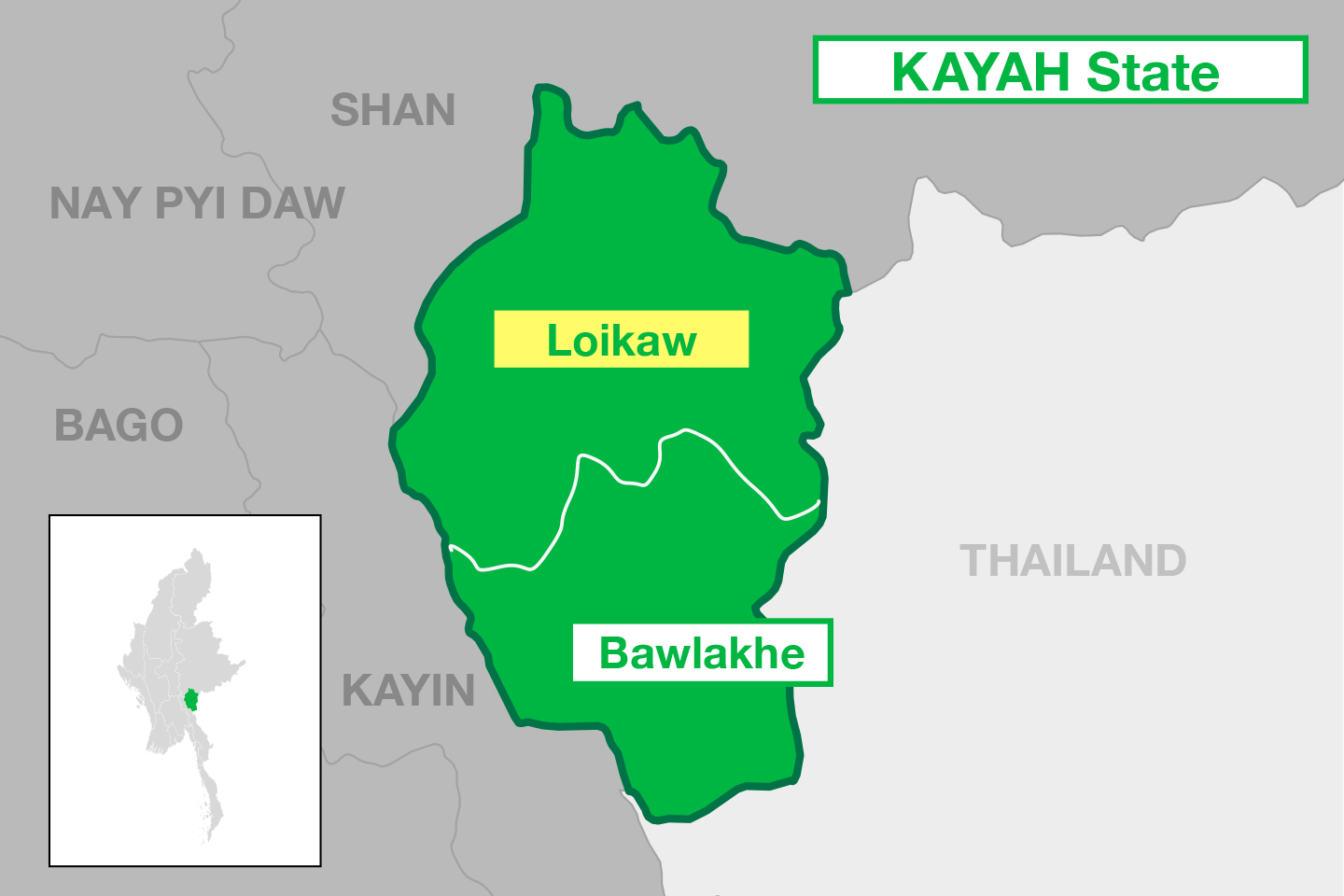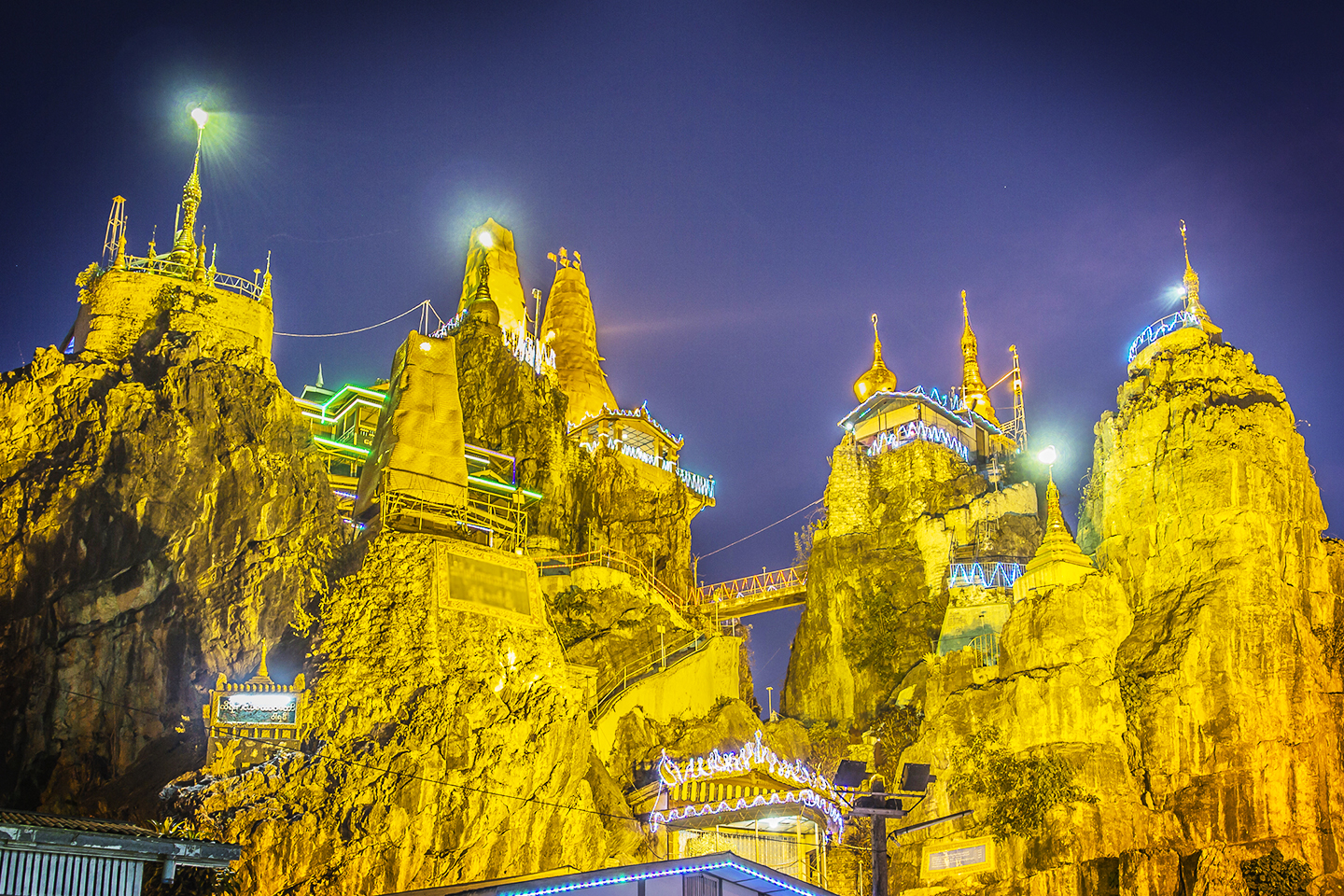 This is the smallest Region in Myanmar. The capital city’s name is Loikaw, and it is located in the eastern side of Myanmar – also known as the Northern Shan state. The location is also very near to the Eastern side of Thailand’s Mae Hong Son province. The landscape is peppered by mountains and is crossed by the Thanlwin (Salween)river, which is one of the main waterways in the area. The Dawna Range and the Karen Hills, also known as "Karenni-Karen" mountains, are separated by the Salween River while it flows through the Karenni (Kayah) state. The Balu Chaung flows from the Inle Lake and into the Than Lwin River, and then eventually joins with the Salween.
This is the smallest Region in Myanmar. The capital city’s name is Loikaw, and it is located in the eastern side of Myanmar – also known as the Northern Shan state. The location is also very near to the Eastern side of Thailand’s Mae Hong Son province. The landscape is peppered by mountains and is crossed by the Thanlwin (Salween)river, which is one of the main waterways in the area. The Dawna Range and the Karen Hills, also known as "Karenni-Karen" mountains, are separated by the Salween River while it flows through the Karenni (Kayah) state. The Balu Chaung flows from the Inle Lake and into the Than Lwin River, and then eventually joins with the Salween.
People
The state is populated mainly by the Karenni group, also known as the Red Karen or Kayah (Sino-Tibetan people). Kayah is where a considerable number of Myanmar's minorities live, which includes the Yinbaw, Bre, Kayin (Karen), the Kayah (Karenni or Red Karen), and the 'longneck' Kayan (Padaung) – arguably the most famous of all.
Transportation
There is a newly-opened airport that caters well to the tourists. Most visitors arrive in the capital of Loikaw from Yangon through flights. Access is available by boat or road from Inle Lake, or through the roads from Heho Airport. It takes around one hour to fly from Yangon to Loikaw. The city now has flights coming and going almost on a daily basis through Air KBZ and Myanmar National Airlines. Tourists can go from Nyaung Shwe / Inle Lake to the Pekong Pier, and then choose to change to a taxi or minivan to Loikaw for a trip that approximately takes 45 minutes. The travel time from Nyaung Shwe to Loikaw when using a personal vehicle takes around 5 hours, and up to 7 hours with public transportation options. It is also possible to travel to Loikaw by road from Yangon city. This journey would usually take two days, with an optional but recommended overnight stay at Taungoo.
Destinations
Taung Kwe Pagoda (Broken Mountain)
 The most popular religious spot in Loikaw is the Thiri-MingalarTaung-kwe Pagoda. Taung Kwe stands for ‘broken mountain’. It is also known as the Thirimingalar Taung Zedi since it was constructed on an area called Thirimingalar. The pagoda has a height of 380 feet and is located on 9 organic hills. It is often referred to as ‘Phaw Pye’ in the Kayah nomenclature. There are excellent views of the amazing landscapes surrounding Loikaw that can be appreciated from the summit.
The most popular religious spot in Loikaw is the Thiri-MingalarTaung-kwe Pagoda. Taung Kwe stands for ‘broken mountain’. It is also known as the Thirimingalar Taung Zedi since it was constructed on an area called Thirimingalar. The pagoda has a height of 380 feet and is located on 9 organic hills. It is often referred to as ‘Phaw Pye’ in the Kayah nomenclature. There are excellent views of the amazing landscapes surrounding Loikaw that can be appreciated from the summit.
Haw Nan Monastery
The Haw Nan Monastery, also known as Kandarawwady Haw Nan, is considered to be one of the most historic structures in Kayah. It was constructed during the 1912-1916 time period by Zaw Bwa Saw Pyar Du Sat Khun Li, then the chief of Kayah. Three staircases ascend up to the monastery building. Traditional photographs and furnishings from ZawBwa’s heritage brings the tourists and visitors back in time to about 100 years ago. In 1994, family members of the previous chief gave the structure to be turned into a monastery.
Naung Yah Lake
Naung Yah Lake is an extremely famous destination for the local population to enjoy a good walk or a jog either in the morning or evening, or maybe even a nice picnic with loved ones. A good number of paddling boats can be rented and ridden over the lake, as well as have opportunities to do fishing around the lovely banks. During nighttime, the locals savor their dinner meals beside the lakeside, where a couple of very good restaurants with a lot to offer can be found.
Loikaw Cultural Museum
The Loikaw Museum is definitely a must-visit destination. It houses an amazing array of old art facts, including some spiritual frog percussion instruments – a mark of Kayah traditions. Other displays include a varied assortment of historical costumes that were worn by Kayah’s many ethnic communities. The English-language section is still under construction and will be open to the public soon. The opening hours start at 9 AM and end at 4.30 PM. The usual visit takes around 45 minutes to an hour to go around the whole museum.
Thirimingalar Market
The market is open for business on a daily basis from 6 AM to 5 PM, but not during the full moon holidays. It has a wide collection of products, such as local produce, vegetables, fruits and spices with nice sights and smells. Tourists can also discover domestic items and textiles that can be used as gifts and memorabilia to remind oneself of the visit to Kayah.
BahoZay Market
Being situated along Daw Na Street, this marketplace has many delicious indigenous food and the usual Burmese tea shops. It is fairly easy to purchase warm and fresh produce. Although, it is important to be careful when making choices. For people visiting Myanmar for the first time, it can be quite a challenge to avoid certain and common travel risks.
Naung Yah Market
This is a relatively smaller market, which is just at the border of Loikaw. It is usually open from 5:30 to 11 AM. Most of the sellers sell local produce. The market is not really open on a daily basis, so it is recommended to inquire with the hotel’s reception desks or tour agents before thinking of visiting.
Demoso Market
This market is situated towards the southern part of Loikaw. The travel time usually lasts around 30 minutes with a private car or with a motorbike from the city proper. The market is open for business 3 mornings in a week’s 7 days (Monday, Wednesday and Saturday). It is highly recommended to visit from around 6 to 10 AM. The marketplace is popular for its millet or rice wine. The sellers live around the area, which provides opportunities for tourists to be able to sample a wide collection of local delicacies. These include the Kayah sausage, special meatballs prepared from an extraordinary recipe, and a special Kayah pepper spice.
Kyet Cave (Ya Sa Ku in the Kayah Language)
The cave is situated about 12 miles towards the eastern part of Loikaw, and is roughly 2,990 meters above the sea level. It is a magnificent and organic cave constructed out of limestone and dolomite materials. Very old coffins made out of wood can be discovered internally within the cave. The coffins are approximately 2 to 15 feet in length. Based on the local stories, these wooden coffins previously housed people’s skeletons. Unfortunately, these relics cannot be found anymore.
Htee Se Kha Waterfall
The waterfall is a one-hour driving distance towards the western area of Loikaw. It is an organic waterfall that bisects the Nant Tan Bat Creek, near the shared borders of the Shan and Kayah states. The local population like to visit the waterfall. This is most definitely true during the New Year holiday season in April. Tourists are required to use shorts and t-shirts during swimming, as opposed to wearing bathing suits.
Lawpita Waterfall & Hydropower Plant
These spots can be found around 12 km towards the eastern section of Loikaw. They have incredible views of cascading water features that are a sight to behold. A lot of fish can visibly be observed beneath the magnificent bluish waters. A hydropower plant is also present there to provide electrical power to various areas within Myanmar. Foreign tourists are required to ask for permission to be able to go to the Lawpita Falls, which is usually accessed through local tour agents.
Aung Tha Pyay Cave
This cave is situated near the Htee Se’ Kha waterfall. Around 10 Buddha statues in sitting positions can be found within the cave. The cave has a length of approximately 1,000 feet. Multiple beehives can be found along the cliffs surrounding the cave.
Lwel Ta Mu Cave
This cave was discovered back in 1948. Based on local stories, an indigenous person had a vision of the cave within a dream and embarked on a mission to look for it. The cave has a depth of 110 feet, a width of 100 feet, and a length of 300 feet towards the eastern direction, and a length of 500 feet towards the west and a height of 30 feet. A pagoda was built by the local population approximate to the cave. By the beginning of the year 2013, a number of pilgrims have constructed additional pagodas to attract better health, learning, and riches. At the moment, there are currently 15 pagodas and 254 statues within the cave. The cave is widely known as a spiritual place. As such, all of the visitors present in the area are expected to dress in s conservative manner.
Ngwe Daung Dam
The dam can be found in the Demawsoe township, 12 miles towards the southern direction of Loikaw. It was constructed in the year 1962. It is the primary dam for irrigation purposes within the Demawsoe area. It is a gorgeous destination to use as a backdrop for taking photos of the golden, silver and ruby-colored mountains.
Phaya Pyu (‘White Pagoda’) Village
This village can be accessed by a very mesmerizing boat trip coming from Loikaw, which usually lasts for around 1 hour and is most enjoyable during the early morning hours. The trip is very scenic, with good views of the roaming local farmers along the banks of the Belu River. Within the village community, tourists can observe the village’s primary attraction – the White Pagoda.
Htee-Pwint-Kan (Umbrella Pond)
The pond is located in the Demosoe township, within the middle of the farmland areas. It is a fairly smaller pond, with a circumference of around 100 feet. The pond is popular due to its muddy foundation layer which expands up into the shape of a rainbow. Local legends say that if a person sees that shape swelling upwards, it will bring good luck.
 English
English 日本語
日本語 မြန်မာ
မြန်မာ 汉语
汉语 國語
國語 ภาษาไทย
ภาษาไทย
